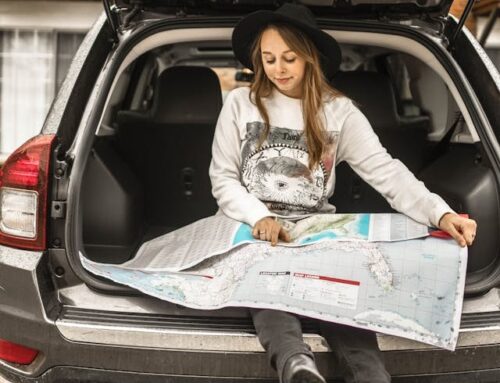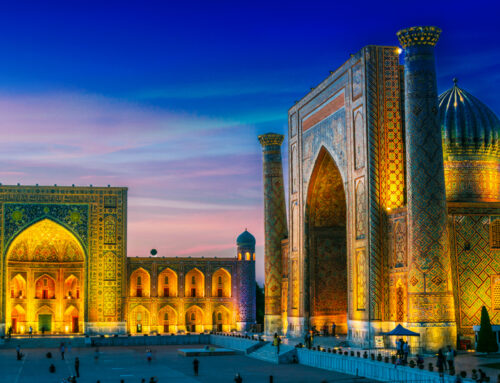Navigating the Swiss Alps: A Road Trip Full of Adventure and Beauty
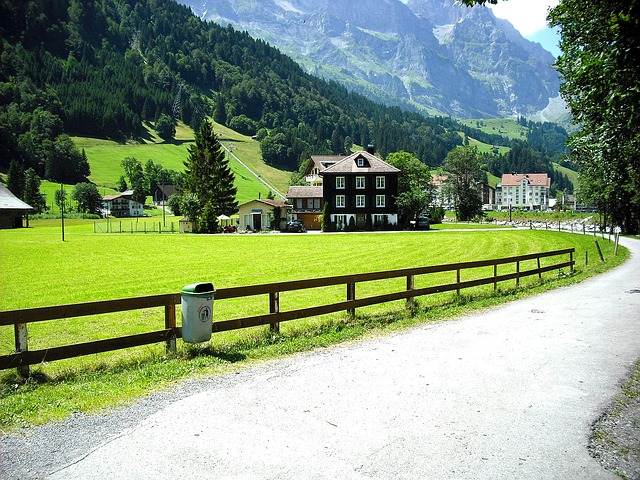
A road trip through the Swiss Alps from Vevey to Zürich unveils a landscape as breathtakingly picturesque as any postcard, and no GPS is needed to find the beauty along this scenic alpine drive.
A road trip through the Swiss Alps offers an unparalleled journey through some of Europe’s most jaw-dropping landscapes. As you wind your way along serpentine mountain roads, you’ll be treated to panoramic views of snow-capped peaks, emerald valleys, and pristine alpine lakes. Whether you’re navigating hairpin turns in summer or admiring the winter wonderland through panoramic train windows, a Swiss Alps road trip promises an unforgettable blend of natural beauty, engineering marvels, and rich cultural experiences.
Starting in Switzerland
I’m in Switzerland which is a stunningly mountainous country in the middle of Europe in the early morning. I’m here to take on part in the Grand Tour of Switzerland, an epic trip that covers the entire country. However, there are no trains in the process (except for one train which will transport me back from Zurich to my point of departure in Vevey).
Sure, I’m going the right direction. A scribbled sign a few kilometers back was able to confirm the same as Grindelwald 20 km. However, it’s pitch black out of the window of the car. The Voice on GPS isn’t as certain. “Turn around when you get the opportunity,” she offers with a happy smile. The fact that I’m on a narrow lane full of bends shuts this option out.
While Switzerland car service offers an alternative to the country’s renowned and dependable luxury car service, it’s how the majority of people travel around visiting the country. Alternatively, Switzerland is renowned for its dependable and extensive train system and it’s how the majority of people travel around visiting the country.
I’m going to be driving though, as I am a huge fan of driving!
So back on the road – Grindelwald is located within the Jungfrau region of the Bernese Oberland. The GPS and I have reached an agreement; it’s currently in the glove compartment (still giving instructions however, it is muffled to a degree) and I’m relying on road signs as well as the precise instructions I was given when leaving Interlaken.
VEVEY TO INTERLAKEN
(144 kilometres, approx 1.5 hours)
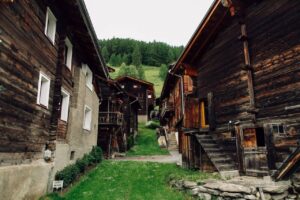
Traditional alpine architecture.
The reality of me driving at night during my first night in Switzerland isn’t entirely my fault. I had written a note to myself to allow ample time to travel towards Interlaken, which is the first stage of my epic journey (Gstaad is supposed to be the next stop), but it was pouring down heavily as I picked up my rental car, and the attendant was insistent that the long drive was a waste of time, as I could see nothing once I reached the top). I went to Grindelwald as I was getting accustomed to driving from the opposite side of the highway and also on one side of the vehicle.
Then I stopped for a funicular train that took just 10 minutes to journey up Harder Kulm, Interlaken’s local mountain, to arrive 1322m above sea level, with an incredible lookout platform and a delightful restaurant positioned as a fairytale castle on the high point.
I was completely captivated. It took only a little cajoling to get me to sit down an seat. Have a glass of wine and maybe a bite or two to sample the first of many meals that would include cheese).
As I sit in the late afternoon sun with Interlaken spreading before me like an enchanted city below, and the majestic trio of Eiger, Monch and Jungfrau mountains dominating the horizon, I realized that my perception of height and size had to be re-evaluated to allow for the sheer beauty of the world surrounding me. I gazed in wonder as time flew by, I watched the world go by, perfectly content.
INTERLAKEN TO GRINDELWALD
(20 kilometres, approx 30 mins)
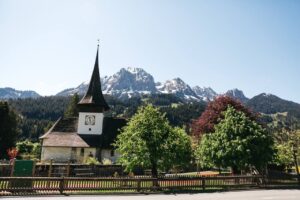
Grindelwald’s church set off by the surrounding peaks.
The journey that should have been a 30-minute drive ended up taking an hour or more (I had to turn around at least once, and went through a small collection of houses, but ended up at an unfinished cow paddock, before I stopped as the GPS was haywire). However, when I finally got to Grindelwald it was an easy task to find my lodgings, The Belvedere with all the lights on is situated at the highest point of the hill. The town is quiet, and it’s getting late, so I decided to stop exploring until early in the morning the following day.
While I’m sleeping, I can see a tiny fleck of light shining through the sky. It’s clearly an astronomical star in the darkness of the night.
The next day I throw back the curtains and am met by an awe-inspiring view of the beauty of The Eiger with its massive peak covered in snow. The light that I believed was an astronomical star the previous night was in fact a beacon that it’s just half-way up the mountain so it’s not surprising that the GPS that went off the rails in the previous night).
The savage granite of the area rising above the city of Grindelwald is stunning. Its base meets a lush green landscape with picture postcard-like chateaus in dark wood that are filled with planter boxes spilling over with red Geraniums.
The Eiger isn’t in my plans today, however. Instead, I’m heading in the opposite direction, towards the Grindelwald First. This is a smaller summit compared to its counterparts, yet still high enough that my wonderful guide, Evelyn, informs me that she has tablets for altitude sickness just in case.
Reached by cable car gondolas, Grindelwald First is famed for its outdoor pursuits. There’s The First Flyer, an intricate flying fox ride that spans across 800 metres, and has speeds of 84 kilometers an hour; numerous hiking trails, and the newly-designed First Cliff Walk, a mix of a 40-metre long suspension bridge that is one rope as well as climbing stairs, and the 45-metre observation platform.
I’m not the one who enjoys the thrills however, so the decision of whether or not to participate in the many options available becomes a matter of debate when we begin our trek to the top and the mist that encircles the peak is a snare. On the summit, there’s only pure whiteness in all directions. We go to the restaurant, and then relax by the window, waiting for it to dry out.
The clouds suddenly disappear and the mountain vista is contrasting with blue skies. It’s like I can almost reach heaven from here. We set out hoping that this change in weather will last but when we climb the stairs the clouds, the sky and the plans we had for the remainder of the day have vanished. I am sighing in relief I am content watching the beauty of nature, the flow and ebb of the clouds.
Then I get to visit the town and the main street throbbing with day-trippers and hikers before heading back to the highway.
GRINDELWALD TO BERN
(75 kilometres, approx 1 hour)
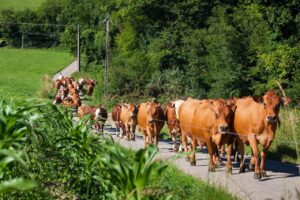
Dairy cows are a frequent sight on rural roads.
After leaving Grindelwald behind, I head to my nwxt destination, the Swiss capital city of Bern by way of backroads that cut through lush cow pastures, dotted with old farm buildings and bordered by peaceful little villages. I am awestruck by the number of wonderful vistas along the way. I am at near the edge of Bern and rely on my GPS to guide me back to the middle the town (we are talking again).
An UNESCO World Heritage site since 1983, Bern’s crowded historical Old Town has evocative cobbled streets and magnificent Renaissance fountains and gorgeous arcades lined with small cafes and shops. The red rooftops of the old homes is my favorite view in the city.
I travel around for a while, and then I find a place to enjoy my new most-loved Swiss dessert: sinking a croissant (Swiss ones aren’t as soft and flaky than the French counterparts) into a hot steaming cup of chocolate.
BERN TO LUCERNE
(109 kilometres, approx 1hr 20)
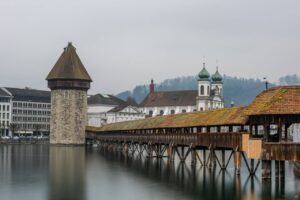
The gorgeous historical Chapel Bridge in Lucerne.
Then, back on the road into the lush countryside as it returns to the peaceful patterns of farmhouses, cows and towns, some with beautiful main streets reminiscent of traditional structures. The way to Lucerne runs through an area called The UNESCO Entlebuch Biosphere, a nature-rich paradise that covers 400 square kilometers near the foot of Alps.
Entering Lucerne is easy as it reveals a stunning lakeside town with a laid-back, welcoming vibe around it. After finding my hotel – the hip hotel Ameron Flora, right close to the water – I headed out to discover the beautiful Chapel Bridge, a covered pedestrian bridge made of wood that was built around the 14th century. It’s right at near the top of a hill. Decorated with flowers, and white swans swimming beneath it It’s the story of fairytales.
The city of Lucerne is great to wander around, crossing across the River Reuss over the various bridges and stumbling through small streets of cobbled stones. It is the way I stumbled to stumble upon the Museum Sammlung Rosengart A stunning collection of artworks of Pablo Picasso.
LUCERNE TO EINSIEDELN
(58 kilometres, approx 1hr)
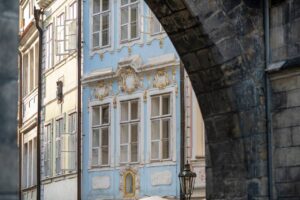
Classic Swiss architecture.
As you leave Lucerne, the city suddenly disappears as structures are less frequent and the view becomes Lake Lucerne on one side and lakeside mansions to the other. After an hour of travel to Einsiedeln the beautiful town of Schwyz is visible. This region is known as the home for the Swiss Army Knife, but it’s the gorgeous town’s medieval centre that draws me in.
The magnificent buildings, some decorated with historic murals have witnessed a lot of time: beginning in the 16th century, the inhabitants from the region were frequently required to join foreign armies. They also returned wealthy with houses that remain proud of today.
Thirty minutes later and the city of Einsiedeln is visible across the horizon, with its main feature the massive baroque abbey coming into view (turning away from the main road in direction of the abbey, I’m looking at the eyes of an animal, its owner slowingly bringing it to the nearby farmyard).
In the church, I crane my neck to gaze at the gorgeously decorated ceilings. But it’s the library accessible through a massive wooden, locked door leading to the cloisters that catches my awe. It absolutely blows my mind! The stunningly curving walls and vaulted ceilings are home to shelves that are filled with a myriad of historical books as well as a plethora of other books beneath. This is one of my most stunning rooms that I’ve seen.
EINSIEDELN TO ZÜRICH
(40 kilometres, approx 40 mins)
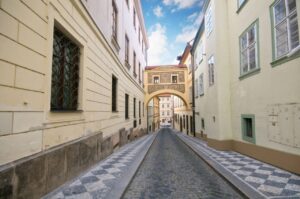
Winding cobbled streets in Zürich
The final part of my tiny journey of the Grand Tour of Switzerland is through Lake Zurich, with intermittent towns (including Rapperswil with its bustling beautiful center and castle) becoming the city’s outskirts with lakeside mansions which are visible from the high walls and decorative gates which gradually grow in size and splendour.
I’m expecting Zurich is a far more attractive option than it currently is. Driving through the town and locating my lodging ( Hotel Ambassador) is fairly easy, given Zurich is mostly free of the urban sprawl that often ruins the first impressions of cities. I am part of an excursion through the old town on the following day, and climb up to the Lindenhof through cobbled streets passing by merchants’ homes and some of the more than 1200 fountains that pour out fresh, drinkable water continuously.
The Lindenhof is a place where people from all over the world come to take a break and enjoy their city. From here, the Limmat River, the Grossmunster Church and the old town are laid out below with the more modern structures from Zurich University and the Swiss Federal Institute of Technology clinging to the hill from the opposite. There aren’t any high-rise structures, no soulless CBD despite being a hub for finance. The city is beautiful, easy to manage and wonderfully Swiss.
According to my guidebook, there are layers of the past beneath the Lindenhof and the ruins of the first Roman fort which once stood here, and the palace that was built in the name of the grandson of Charlemagne in the 9th century. These are easily reached by simply contacting the tourism authority in the area and seeking keys. So Swiss.
My final morning in town,, I set off to drive my car that I had hired back to the airport, relying once more in my personal GPS (we were old pals at this point). What was supposed to be an easy 10-minute drive to the other end of town took me 40 minutes to navigate through the streets of residential areas and through some areas of the city I wouldn’t have experienced.
And I was 100% certain I was doing it the right direction.
*********************************
About The Author: Laxmi Kumari is a dedicated professional working on Switzerland Car Service, specializing in luxury car transportation. With a focus on customer satisfaction, she ensures smooth, reliable travel experiences across Switzerland.

